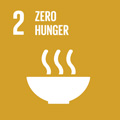- Docente: Giorgio Prosdocimi Gianquinto
- Credits: 6
- SSD: AGR/04
- Language: Italian
- Teaching Mode: In-person learning (entirely or partially)
- Campus: Bologna
- Corso: First cycle degree programme (L) in Agricultural Technology (cod. 5832)
-
from Sep 22, 2025 to Dec 17, 2025
Learning outcomes
At course completion the student acquires knowledge on the main features and problems of the horticultural sector, with reference to the Italian and international scenarios; possesses the basic knowledge to produce vegetables under greenhouse and in open field; gains the ability to analyze the cultivation systems of the main vegetable crops.
Course contents
a) Prerequisites
The students who access this course have a good knowledge of the fundamentals of biology and botany and are skilled in agronomy, agro-meteorology, bio- and soil-chemistry that allow him to understand the issues of both open field and greenhouse vegetable crops. The students also have the basics of inorganic chemistry and physics that allow them to learn about aspects of water and mineral nutrition of vegetable crops. These prerequisites are provided during the first two years of the bachelor program
Under the big theme of the innovations in crop production, to acquire the ability to check, select and manage the most efficient and sustainable production systems for vegetable crops is a priority in the formation of a modern agronomist, and for those who want to continue their studies enrolling in master courses.
b) Contents / teaching units
The course covers the bases and principles of vegetable crops and deals with the general criteria that are useful for the analysis and selection of crops and technologies. It includes topics of interest for the design, organization and management of sustainable productive systems, with particular attention to the rational use of resources. The course consists of six teaching units supported in part by a textbook (see section readings/bibliography) and partly by the teaching material (e.g. slides) distributed by the teacher.
The teaching units (UD #) are:
UD # 1) Reference scenarios
1.1) Sustainability and ethics of vegetable production
1.2) Statistics on vegetable crops (economic importance)
1.3) Quality of Vegetable crops (quality characteristics, evolution of the concept of quality, regulatory and legislative aspects)UD # 2) Plant propagation
2.1) Propagation by seed
2.2) Propagation by grafting (herbaceous grafting)
2.3) Micropropagation (hints)
2.4) The nursery
2.4.1) Business organization
2.4.2) Containers and substrates
2.4.3) Control of the size of the plants
UD # 3) Vegetable cropping systems in open field
3.1) Farming systems (“conventional”, integrated, organic
3.2) The environment (general considerations on climate and soil) and concept of "vocational area"
3.3) Rotations
3.4) Soil preparation and crop planting (direct sowing and transplanting)
3.5) Irrigation
3.6) Fertilization
UD # 4) Protected cultivation
4.1) Types of protection (defense systems, semi-forcing and forcing systems)
4.2) Climate and its conditioning in greenhouse
4.3) Greenhouse cover materials (hints)
UD # 5) Soilless culture
5.1) Main soilless systems
5.2) Nutrient solution
UD#6) The crops
Botanical classification, biological characteristics, environmental requirements and adaptation, cultivation practices, harvesting and product quality, and pest and diseases (hints) of main vegetable species belonging to the families: apiaceae, asteraceae, brassicaceae, chenopodiaceae, cucurbitaceae, fabaceae, liliaceae, and solanaceae.
Readings/Bibliography
The reference book is:
Pardossi A., Prosdocimi Gianquinto G., Santamaria P., Incrocci L. (editors), Orticoltura: Principi e pratica, Edagricole, Bologna, 2018 (chapters 1, 4, 5, 6, 7, 9, 10, 13, 14, 15, 16, 17, 18, 20, 21).
The book will be integrated with slides and other material provided by the teacher.
During the course, a copy of the power-point presentations carried out in class will be made available online.
The following text is recommended for further study:
Baudoin W., Nono-Womdim R., Lutaladio N., Hodder A., Castilla N., Leonardi C., De Pascale S., Qaryouti M. (eds.), Good Agricultural Practices for greenhouse vegetable crops: Principles for Mediterranean climate areas, FAO Plant Production and Protection Paper n° 217, FAO-UN, Roma, 2013 (***).
(***) e-books made available in PDF format by the teacher
Teaching methods
The course consists of lectures and exercises, which may include:
- Films and documentaries to explore the topics of class,
- Seminars held by visiting professors or experts on issues of particular interest,
- Technical tours to farms, nurseries and / or marketing centers
- Practical activity in vertical farm and/or in greenhouse.
Assessment methods
For this course, students’ skills will be assessed through a final written examination in the form of a multiple-choice quiz. The quiz consists of 60 closed-ended questions drawn from the six teaching units, based on the reference textbook chapters and lecture notes. Each question offers 3, 4, or sometimes 5 answer choices, but only one option is correct.
The test is individually generated for each student by the EOL platform, and the navigation is sequential—once you proceed to the next question, you cannot go back.
Students are not required to answer all 60 questions, but they must answer at least 32. If fewer than 32 questions are answered:
-
Each correct answer is worth 1 point.
-
A penalty of 0.5 points is applied for each unanswered question.
-
Incorrect answers do not incur any penalty.
If 32 or more questions are answered:
-
Each correct answer is still worth 1 point.
-
No penalty is applied for incorrect or unanswered questions.
The final score is calculated as follows:
1) If the student answers 32 or fewer questions:
The final grade is the algebraic sum of the scores:
-
Example: 28 questions answered, 22 correct → (22 × 1) − (4 × 0.5) = 20
-
Example: 27 answered, all correct → (27 × 1) − (5 × 0.5) = 24.5 (rounded to 25)
-
Example: 32 answered, 20 correct → 20
-
Example: 32 answered, 18 correct → 18
-
Example: 32 answered, 30 correct → 30
-
Example: 32 answered, all correct → 30 cum laude
2) If the student answers more than 32 questions:
The final grade is calculated proportionally to 32, based on the number of correct answers:
-
Example: 50 answered, 20 correct → (20 / 50) × 32 = 12.8 (rounded to 13)
-
Example: 50 answered, 29 correct → (29 / 50) × 32 = 18.6 (rounded to 19)
-
Example: 50 answered, 40 correct → (40 / 50) × 32 = 25.6 (rounded to 26)
-
Example: 50 answered, 47 correct → (47 / 50) × 32 = 30.1 (rounded to 30)
-
Example: 50 answered, all correct → (50 / 50) × 32 = 32 (30 cum laude)
A final score of 31 or higher results in a 30 cum laude.
The maximum duration of the written exam is 60 minutes.
Teaching tools
PC, projector, PowerPoint presentations, video / DVD.
Office hours
See the website of Giorgio Prosdocimi Gianquinto
SDGs




This teaching activity contributes to the achievement of the Sustainable Development Goals of the UN 2030 Agenda.
